Parity 1 Sows More Susceptible to Heat
December 22, 2011

Heat stress can decrease farrowing rates and depress litter size for sows and gilts. Heat-stressed sows may also produce less milk, resulting in smaller piglets at weaning.
Attempts to modify farrowing room environment to reduce heat stress commonly center on reducing the internal body temperature of the sow during periods of high ambient temperatures.
Two types of farrowing room ventilation systems are forced air (FA) and evaporative cooled (EC). In FA facilities, outside air is pulled into the barn through inlets at the top and side of the room by fans located on the opposite wall. Fans pull air across the pigs at a rapid rate to allow for cooling.
In EC facilities, water drips between ridged pads mounted on the side or end of the building. Fans pull the air through the pads, cooling the air by evaporation as it travels through the room and across the pigs. Field observations suggest evaporative cooling can reduce ambient temperatures by 10° F. or more.

Two trials were performed — one in June-July 2010, the other in June-July 2011 — to study the thermal response of different parity lactating sows housed in EC and FA farrowing rooms. Landrace or Landrace x Large White Parity 1 (P1) or multiparous (up to Parity 7) sows were used. The EC and FA rooms were located within the same farrowing building on the University of Missouri Swine Research Complex.
In both trials, sows were moved from the breeding barn to farrowing rooms about one week before expected farrowing dates. Thirty-five sows were studied in 2010, 28 sows in the 2011 trial. Sows were split between the two rooms, with similar numbers of same parity sows housed in each room. Thermal temperature measurements were taken at 9 a.m. and 3 p.m. on Monday, Wednesday and Friday from the day they entered the farrowing rooms until a few days after weaning.
Measurements included rectal temperature (thermistor thermometer with a probe), ear and shoulder temperature (infrared thermometer), and respiration rate (breaths/minute). Outside and room ambient temperatures were measured by temperature sensors. For both trials, average ambient temperature was lower in the EC room compared with the FA room.
Farrowing was associated with an increase in rectal temperature for all parities (Figure 1). However, the average rectal temperature after farrowing was greater in P1 sows (102.2° F) vs. multiparous sows (101.5° F). Interestingly, rectal temperatures of sows housed in both rooms were similar, indicating that although the ambient temperature in the FA room was greater than the EC room, the sows in the FA room apparently coped with the higher temperature by increasing vasodilation and respiration rate to keep their body temperature stable.
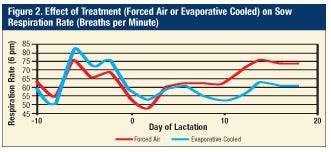
For all sows, shoulder temperature increased after farrowing and remained elevated throughout lactation. P1 sows had a greater increase in shoulder temperature from the morning to the afternoon (93.7 to 96.4° F) compared to multiparous sows (94.1 to 96.1° F).
For all sows, ear temperature increased from 95.5° F before farrowing to 97.7° F after farrowing. The ear temperature of P1 sows increased from 95° F in the morning to 97.5° F in the afternoon. In multiparous sows, however, ear temperature only rose from 95.5° F in the morning to 97.2° F in the afternoon.
Sows in both rooms had similar respiration rates two days before farrowing (Figure 2; 69 and 75 breaths/minute, respectively), but sows in FA rooms had a greater respiration rate by late lactation than EC sows (74 vs. 61 breaths/minute, respectively). P1 sows also had a greater increase in respiration rate from the morning to afternoon (55 to 73 breaths/minute) compared with multiparous sows (58 to 66 breaths/minute).
These trials showed that the thermal response of first-parity sows is different from multiparous sows during heat stress. P1 sows are more sensitive to heat stress as indicated by their body temperatures and respiration rate; they also had higher rectal temperature during lactation than older sows. This difference could be due to variation in metabolism; P1 sows may have a more severe metabolic demand as they are partitioning energy toward both milk production and body growth. Another explanation is that P1 sows are experiencing their first summer heat stress period and may not have physiologically adapted to heat stress.
Since P1 sows are more sensitive to heat stress than older sows, it may be beneficial to provide a significant cooling mechanism throughout lactation to prevent overheating.
Researchers: Whitney R. Martin, Tim J. Safranski and Matt C. Lucy, University of Missouri. For more information, contact Martin at (703) 568-65211 or e-mail: [email protected].
Litter Size Does Not Guarantee Profitability
Greater emphasis on improving pigs born/mated female/year has given rise to more questions about the viability and profitability of larger litters. In this study, “Economic Implications of Increased Variation in Litter Size,” the goal was to quantify the impact of increasing litter size from an average of 8.8 pigs/litter to the extreme end of the range at 20.8 pigs/litter.
As litter size increases, the proportion of lightweight pigs also increases and, thus, impacts profitability. The study found that as average litter size increased, total profit increased for the sow herd in the model, but at a declining rate.
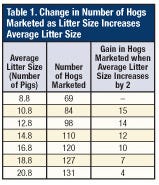
While increasing litter size decreases fixed costs per head, the potential for reducing the biological performance of all of the pigs in the litter also exists. The objective of this project was to evaluate how changes in a sow herd’s average litter size affect the group’s profitability.
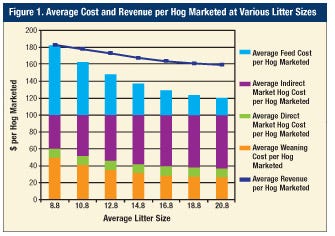
Biological sow and piglet performance data were used to calculate the economic implications of variations in litter sizes. The analysis used a small-scale, hypothetical 10-sow demonstration herd to populate litters and assess the performance of piglets under various average litter size scenarios. The distribution of sow parity was modeled using estimates of sow survival rates. Two distinct distributions were used to model piglet birth weights to clearly distinguish the performance differences of light vs. heavy birth weight piglets, with further adjustment accounting for sow parity differences.
Estimates of 21-day pig weights were made, incorporating effects of sow parity and number of piglets nursed per litter. Adjustments for (post weaning) growth parameters were made for sow parity, number born and nursed, sex, daily feed intake and stocking density. Pig probability of survival was modeled from birth to weaning (21 days of age), end of nursery (55 days of age) and at first marketing (150 days of age).
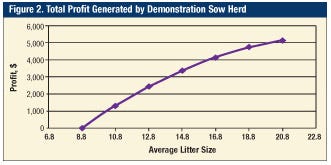
Specific biological relationships were used to simulate sow performance and pig growth and used to calculate the economic implications of variations in litter sizes. To estimate profitability of the sow herd, the costs and revenue for each market hog were calculated. Three marketing cuts were made – the heaviest 17% at 150 days of age, a second cut of the heaviest at 163 days of age (34% of hogs), and a final marketing at 179 days of age (49%). Carcass weight and percent lean were used in the pricing grid.
Production costs were broken into four areas:
1. Feed costs — Eight diets using 15 ingredients.
2. Weaning costs — Sow gestation and farrowing costs (sow feed, veterinary care, barn allocation, utilities and labor), which were offset by expected sow cull revenue. At $345/litter, the weaning costs were allocated equally across all pigs born in a litter.
3. Direct market hog costs — Veterinary care, fuel and utilities in grow-finish, mortality losses and marketing. A $10.05/head charge was applied to each pig that survived through Day 55.
4. Indirect marketing costs — Interest on the value of pig feed, grow-finish facility and equipment costs and labor. A cost of $269.08/sow was spread across all live pigs through Day 55.
As one measure of performance, costs and revenues per market hog were calculated. Alternatively, the cost and revenue for each pig born could be assessed. The averages would differ from hogs marketed due to death loss, which would increase as litter size increased. But larger litters would also spread the various other costs over more pigs.
Table 1 shows the number of hogs marketed from the 10-sow demonstration herd with corresponding average litter size. While the average litter size is increasing by two pigs/litter, the number of hogs marketed is increasing at a declining rate. For example, when litter size increased from 8.8 to 10.8, the number of additional market hogs was 15. However, when average litter size increased from 18.8 to 20.8, only four additional hogs were marketed. Therefore, the cost/pig born vs. average cost/pig marketed, broken into the four defined cost areas, is vastly different (Figure 1).
Aggregating the costs and revenues for the group shows total profit for different average litter sizes (Figure 2). Overall, increasing the average litter size increases total profit, but at a decreasing rate. At some point beyond 20.8 pigs/litter, total profit is expected to plateau or decline. Of course, the true cost of larger litters has many variables, which differ in each production unit. Improved management methods could better manage larger litters and improve the prospects of profitability.
Researchers: David Widmar, Nicole Olynk, Brian Richert, Allan Schinckel and Ken Foster, Purdue University. For more information, contact Olynk at (765) 494-2567 or e-mail: [email protected].
Feeding Level Associated with Puberty, Estrous Traits
Replacement gilts that never farrow a litter are an economic loss for producers. Research shows 10 to 25% of gilts that display estrus do not go on to farrow a litter.
A recent study from North Carolina State University shows that the length and strength of estrus are associated with the likelihood that a gilt will farrow a litter. Therefore, identifying management strategies to improve estrous traits offers an opportunity to reduce the number of gilts culled for failure to farrow.
In this study, 360 gilts were reared from 199 to 268 days of age in a gilt development unit and then split between two commercial sow farms in southern North Carolina.
During the development period,
gilts were fed typical gestation diets either ad libitum or restricted to 4.5 lb./day. Females were Landrace, Large White or Landrace × Large White crossbreds, Genetic Improvement Services (Newton Grove, NC).
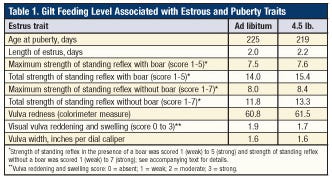
Estrous traits measured were age at puberty, length of estrus, maximum strength of standing reflex with or without a boar present, total strength of standing reflex with or without a boar present, vulva redness, strength of vulva reddening and swelling and vulva width.
Associations between gilt feeding levels with estrous and puberty traits are shown in Table 1. The scoring system for strength of standing reflex traits in the presence of a boar was 1 (weak) to 5 (strong). The score is a composite of gilt reflexes before, during and after the back-pressure test was applied every 12 hours while in estrus. Maximum strength of standing reflex with a boar was the sum of the two largest scores. Total strength of standing reflex is the sum of all strength of standing reflex scores.

Scoring of standing reflex without a boar present is slightly broader, with scores ranging from 0 (weakest) to 7 (strongest) and was scored at least 20 minutes after fenceline contact with a boar had occurred. The “maximum strength” and “total strength” scores were, likewise, summed as described above.
Gilts fed the restricted level had reduced age at puberty, increased length of estrus and increased total strength of standing reflex with a boar. The remaining three standing reflex traits were also numerically higher in gilts fed a restricted diet. Thus, restricted feeding was associated with improving estrous length and strength. Furthermore, a higher percentage of gilts in the restricted feeding regime farrowed a litter — 78% vs. 73% fed to ad libitum.
This study indicates that gilts should be fed restrictively from 199 to 268 days of age to minimize feed costs and because it has a positive impact on standing reflex traits, specifically length and strength of estrus.
Researchers: Mark Knauer, Joe Cassady and M. Todd See, North Carolina State University; and Douglas Newcom, Newsham Choice Genetics. For more information, contact Knauer at (919) 515-8797 or e-mail: mtknau
[email protected].
Genetic Resistance to PRRS Makes Selection Plausible
Six hundred commercial crossbred pigs were experimentally infected with the porcine reproductive and respiratory syndrome (PRRS) virus. Blood samples were collected and body weights recorded at least once per week throughout the six-week test period.
Blood samples were used to measure the degree of infection through viral load. Body weight was measured to look at the impact of the PRRS virus on growth. Serum viral load from Day 0 to Day 21 were summarized by area under the curve.
Heritability for viral load and weight gain from 0 to 42 days after infection was 0.28 and 0.26, respectively. All piglets were genotyped for over 60,000 genetic markers comprising single nucleotide polymorphisms (SNPs) distributed across the genome. Regions on chromosomes 3, 4, and X appeared to be associated with area under the curve, while regions on chromosomes 1, 4, 7 and 17 appeared to be associated with weight gain.
These results are promising, as it shows there is genetic variation for resistance or susceptibility to PRRS within a population and that selection for resistance to the virus is plausible.
Further work is needed to confirm the predictive ability of specific markers and regions identified to date, and to ensure they confer reduced susceptibility to other strains of the PRRS virus. Given satisfactory validation, producers will be able to genotype their animals and have them ranked for resistance to PRRS viral load using a small number of specific markers at a lower cost than using the 60k BeadChip.
Researchers: Dorian Garrick, James Reecy, Jack Dekkers and Max Rothschild, Iowa State University. For more information, contact Garrick at (515) 294-2080 or e-mail: [email protected].
Two Traits Help Identify Gilts Most Likely to Farrow
Ten to 25% of gilts detected in estrus never farrow a litter. Gilts selected and acclimated for the breeding herd that do not farrow are an economic liability.
Few studies have associated gilt development traits with their likelihood of farrowing. Therefore, the objective of this study was to associate gilt entry, puberty, estrus, growth and composition, and structural conformation traits with whether a gilt will farrow a litter.
A total of 1,225 gilts were placed in a development unit from 162 to 265 days of age and then sent to one of two commercial sow farms in southern North Carolina. Females were Landrace, Large White or Landrace × Large White crossbreds, provided by Genetic Improvement Services (Newton Grove, NC).
Twenty-seven gilt development traits were measured (Table 1). Sow farms were modern confinement facilities that housed 4,200 or 2,400 sows, respectively.
Throughout gestation, females had continuous access to water and were fed according to body condition. Gilts were checked for estrus once daily using fenceline contact with a boar. Gilts were artificially inseminated (AI) at 12 and 36 hours after first detected estrus.
Of the 27 traits measured, only two were associated with whether a gilt farrowed. Longer length of estrus and stronger maximum strength of standing reflex with a boar were associated with a higher percentage of gilts farrowing a litter.
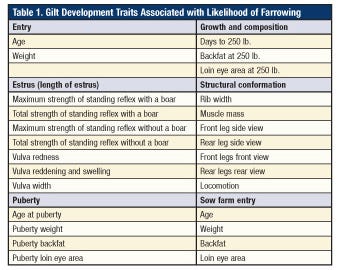
The relationship between length of estrus and whether a gilt farrowed was non-linear. Gilts that exhibited standing estrus for less than 1.5 days were less likely to farrow a litter. Researchers speculated that twice-a-day estrous detection may have increased the farrowing percentage, although the commercial farms did a respectable job of detecting estrus, as conception rates were 85%.
New research should identify management and genetic strategies that optimize length of estrus and maximize strength of standing reflex with a boar present.
Researcher: Mark Knauer, North Carolina State University. For more information, contact Knauer at (919) 515-8797 or e-mail: [email protected].
AI Timing Can Improve Fertility of Frozen Boar Semen
Frozen-thawed boar semen (FTS) is not readily used in modern swine production due to lower fertility rates when compared to extended liquid semen. But progress is being made. Improving the timing of artificial insemination (AI) in relation to ovulation can increase pregnancy rate and litter size.
With fresh, extended liquid semen, the goal is to inseminate the female 24 hours before ovulation. With frozen semen, AI timing is even more critical, the goal being to inseminate the female about 12 hours before ovulation.
The objective of this experiment was to determine the effect of various insemination intervals on fertility measures, including final pregnancy rate and litter size, as well as to establish the effect of the first and second insemination on the paternity of the resulting fetuses.
The experiment was conducted in multiple replicates at the Swine Research Center at the University of Illinois-Urbana. A total of 191 mature terminal line gilts were synchronized using Matrix (Merck Animal Health, Summit, NJ). Estrous detection was performed at 12-hour intervals following last Matrix feeding. Trans-rectal ultrasound was performed at 12-hour intervals following detection of estrus to estimate time of ovulation. At onset of estrus, gilts were randomly assigned to one of the following treatments:
• 4-hour AI interval (34 and 38 hours);
• 8-hour AI interval (30 and 38 hours); or
• 16-hour AI interval (22 and 38 hours).
Gilts received two billion motile sperm in 80 mL of Androhep CryoGuard Thaw Extender (Minitube of America, Verona, WI) by intra-cervical AI at assigned AI times. Each insemination was of a distinct sire in order to determine fetal paternity. Each sire was represented across treatment and first and second insemination.
Semen was collected from 11 boars of various breeds in a continuous collection rotation from August 2010 to August 2011. Semen was extended 1:1 in Modena Extender (Swine Genetics International, Cambridge, IA) and shipped overnight to the University of Illinois where it was frozen in 0.5 mL straws. Straws were stored in liquid nitrogen until post-thaw evaluation.
Straws were thawed at 50°C (122°F.) for 20 seconds and diluted into Androhep CryoGuard Thaw Extender (Minitube of America) for evaluation of motility, viability and acrosome integrity. Post-thaw sperm measures averaged 52.1% motile, 56.6% viable and 99.7% acrosome intact for live sperm.
At Day 31-36 following breeding, reproductive tracts were collected from gilts at a local abattoir. Final pregnancy rate and litter size were assessed and fetal tissue samples collected for paternity testing.
Insemination interval affected final pregnancy rate. Gilts receiving inseminations at eight-hour intervals had a pregnancy rate of 75.5%, while those inseminated at 16-hour intervals had a pregnancy rate of 67.4%. Gilts inseminated at four-hour intervals had a 51.5% pregnancy rate. However, litter size at Day 35 was not affected by treatment and averaged 10.2 fetuses/litter (Table 1).

Estrus-to-ovulation interval also influenced final pregnancy rate, but did not influence litter size. Gilts that ovulated by 36 hours (82.9%) and 48 hours (77.6%) had significantly higher pregnancy rates than those that ovulated by 24 hours (54.8%) and 60 hours (44.1%) after the onset of estrus.
The preliminary results of this study suggest that when using FTS in a double insemination system, the greatest fertility occurs when estrous detection occurs at 12-hour intervals and with inseminations timed to occur at either 8- or 16-hour intervals.
This result most likely reflects the short, fertile life span of frozen boar sperm and the variation in timing of ovulation after estrus. Inseminations too close together can reduce fertility of frozen boar sperm.
Researchers: Jennifer M. Ringwelski and Robert V. Knox, University of Illinois-Urbana. For more information, contact Ringwelski at (217) 244-5177 or e-mail: [email protected].
Thawing Step is Critical to Frozen Boar Semen Fertility
The ability to successfully freeze and thaw boar semen has limited the acceptance of frozen semen in the swine industry. The fertility of frozen-thawed boar semen has been lower than extended liquid semen.
While the freezing process may be a major limitation to sperm survival, the effect of thawing rate also influences the post-thaw quality of frozen-thawed boar sperm. The objective of this experiment was to evaluate the effect of various thawing temperatures and the duration of thawing on post-thaw fertility measures of boar sperm during time in storage.
Conducted at the University of Illinois, this study included 15 ejaculates from 13 boars of proven fertility. Ejaculates, collected and frozen from March 2010 to March 2011, were frozen in 0.5 mL straws using Androhep CryoGuard Freezing Extender (Minitube of America, Verona, WI) at a concentration of 1.4x109 cells/mL. To test for the effects of thawing temperature and duration of thawing on fertility at various times during storage, individual straws from each ejaculate were assigned to all temperatures, thawing durations, and time in storage. The treatments included straws thawed at 50° C (120° F) for 10, 20 and 30 seconds, as well as 70° C (158° F) for 5, 10 and 20 seconds and storage times of 5, 30 and 60 minutes post-thaw. All straws were thawed using thermally controlled water baths.
Following thawing, the sperm was expelled into a glass tube held in a 37° C (98.6° F) heating block. Semen samples were then diluted 1:40 in Androhep CryoGuard Thaw Extender (Minitube of America) at 37° C (98.6° F) and evaluated for post-thaw motility during storage. To evaluate for numbers of live sperm, thawed sperm were diluted 1:50 in BTS semen extender (Minitube of America) at 26° C (78.8° F). Samples were evaluated at 5, 30, and 60 minutes post-thaw for motility at 200X (magnification) in 10 fields and for number of live sperm using propidium iodide staining.
Thaw temperature and duration of thawing affected post-thaw motility and the number of live sperm. Post-thaw motility was similar for all treatments — about 41% motile — except when straws were thawed at 70° C (158° F) for 20 seconds, which were 3% motile (Figure 1a).
For sperm viability, thawing at 70°C (158° F.) for 20 seconds resulted in few live sperm (6%) compared to most of the other treatments, about 56% live, while thawing at 70°C (158°F) for only five seconds resulted in lower numbers of live sperm — 50% (Figure 1b).
Results of this study indicate that for boar sperm frozen in 0.5 mL straws, the highest fertility results when frozen boar sperm is thawed at 50° C (122° F) for 20 seconds or 70° C (158° F) for 10 seconds. However, due to critical effects of only a few seconds shorter or longer when thawing at 70° C, this high temperature may not be the best procedure.
The lack of flexibility in thawing duration could be problematic as thawing at 70° C (158° F) for only five seconds reduces fertile sperm; 20 seconds at that temperature kills most sperm. We recommend 50° C (120° F) for 20 seconds, as it provides optimal fertility and conveys some flexibility in thawing temperature and time.
Researchers: Kelli A McNamara and Robert V. Knox, University of Illinois-Urbana. For more information, contact McNamara at (217) 244-5177 or email: [email protected].
You May Also Like



